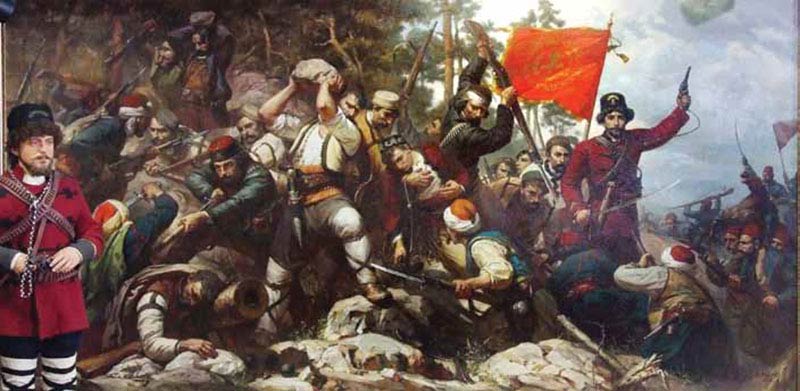For the Macedonian people, as for neighboring peoples in the Balkans, the 19th century and the beginning of the 20th century were full of armed insurrections aimed at the overthrow of Osmanli political domination. and the formation of national states. The first wave of insurrections (1804-1830) washed over Serbia, Greece and Romania, and the second over Bosnia and Herzegovina, Bulgaria, Macedonia and Albania (1876-1889) .
The Macedonians, organized for the first time, took up arms in the Razlovci Uprising of May 1876. This rebellion was autochthonous and short-lived, but had clear national and political goals: it was planned to spread and intensify the rebellion in order to bring about the diplomatic intervention of Europe on Macedonia’s behalf. The character of the rebellion was revealed in the symbols on the rebels’ flag: a figure of a lion rampant on a red background, and above it, the motto “Rise up that I might liberate you, Macedonia”.
The second uprising (the Kresna Uprising) took place in October 1878 in an utterly new situation; it was a reaction to the decisions of the Congress of Berlin and was greatly influenced by Russian victories in the war to liberate Bulgaria ( 1877-78), in which hundreds of Macedonians took part as volunteers. The uprising began along the middle course of the Struma river, reached the Russo-Turkish demarcation line, and spread to neighboring regions. It is important to note that among the rebels were people from all parts of Macedonia and among the above-mentioned volunteers the leading political figure was D. Berovski, whose fighters continued their activities beyond 1876 right up to the end of the Russo – Turkish war. Local rebel organizations were esta blished in the liberated villages, regulated by a specific constitution, and the ultimate goal was to establish political autonomy for Macedonia. The national and liberationist character of the uprising is clearly expressed in the programmatic document “Constitution (Regulations) of the Macedonian Uprising Committee”, and in the inscription on the seal “Seal of the Chief of Staff of the Macedonian Uprising, 1878”. The uprising was put down in June 1879 but it had further repercussions in western Macedonia in the area between Bitola, Ohrid and Kicevo, in the Prespa region, the vicinity of Kostur, etc.
The Osmanli reaction was brutal; many people were imprisoned, and even more were exiled, mainly to Bulgaria, Serbia and Romania. This was a heavy blow, especially to the intelligentsia (teachers and priests), popular leaders and Macedonian patriots. It took a decade for these forces to regroup to the point at which they could initiate a new phase in the struggle for liberation. Thus, in 1893, the Macedonian Revolutionary Organization was formed in Salonica, later to be known first as the Secret Macedonian Odrin Revolutionary Organization (TMORO), and then as the Internal Macedonian Odrin Revolutionary Organization (VMORO). In the decade before the uprising of 1903, this organization spread its network throughout the territory of Macedonia and devised a complex organizational structure, from village committees up to the Central Committee and Representatives Abroad, it became a mass popular organization, led by the intelligentsia and with grass-root support primarily among the Macedonian peasantry. The main role in winning mass support for the organization was played by the armed formations (chetas), with one or two in each district. Their commander was Goce Delcev from Kukus, an inspired organizer and ideologist of the movement (Delcev was killed in a battle with a Turkish regiment in May 1903). The basic programmatic goal of TMORO was to win statehood for Macedonia. Its military slogan was “Macedonia for the Macedonians”. Membership of the organization was open to all oppressed inhabitants, and it included a great number of Macedonian Vlachs (Aromanians), as well as Greeks and Jews.
St. Elijah’s Uprising (Ilindensko Vostanie), August 2, 1903
On St. Elijah’s Day, Ilinden, August 2nd, 1903, in answer to TMORO’s call, the people rose up in rebellion. During the previous month preparations had been made and the whole territory divided into rebel regions and districts led by staff officers. The fiercest battles were fought in the Bitola region of western Macedonia. The armed rebels, who numbered about 30,000, were under the command of the General Staff. In the course of the first month of the rebellion, they gained control of an area of about 10,000 sq. km. Many of the rebels were recruited from Macedonian emigrants, students and workers who had been organized in all the neighboring countries, and some of whom had even come from Russia, Istanbul and Asia Minor. By the end of August. the offensive had liberated several hundred villages and small towns.
The greatest rebel victories were achieved in the Krusevo area. On August 3rd, 1903, the city of Krusevo with its 10.000 inhabitants of Macedonian and Vlach origin was liberated. The regional staff of the rebels immediately set out to organize a new local authority with representative executive and legislative bodies, known to history as the Krusevo Republic. The leader and organizer was Nikola Karev, a teacher from Krusevo. The new bodies included elected civilians from the three church communities: the Exarchy, the Patriarchate, and the Roman community. However, the Republic lasted for only ten days; under siege, it could not withstand the bombardment of the enemy artillery. Its most tenacious defender was Pitu Guli, a Vlach from Krusevo and voivode (duke) of a regiment, whose bravery was later praised in many folk songs.
During the uprising, the Internal Organization took various steps to inform the world opinion of the intentions and ideas of the uprising. The most important diplomatic document was the “Declaration of the Internal organization to the Governments of the Great Powers” issued on August 10th, 1903, which was sent to the missions of the great powers in Sofia, and published in “Autonomy”, the organ of their Representative Office Abroad.
The Declaration began from the premise that, in the absence of any visible solution by peaceful means, the Christian population was forced to resort to armed self-defense in order to induce the involvement of Europe. The intervention of the six European powers was expected, in accordance with their recognized obligations as set out in the Treaty of Berlin (1878). Considering that the palliative measures taken in the intervening years had only worsened the situation, and with a view to a more efficient intervention of the great powers, the Declaration demanded that the following principles be taken into consideration:
1. The appointment, with the agreement of the great powers, of a Governor-General, who would be a Christian from Macedonia, who had never been part of the Osmanli administration, and who would perform his functions independently of the Sublime Porte.
2. The introduction of permanent international controls, with wide powers to introduce sanctions.
Furthermore, it is stated that if the above-mentioned are not implemented, the Internal Organization will continue to support the popular struggle and will take no responsibility for any unwanted consequences.
In September, the Ottoman army began a counter-offensive, and military confrontation continued until the middle of November 1903. Faced with the military superiority of the enemy and the severity of winter, the General Staff ordered a cessation of hostilities. Nevertheless, in the following years there were sporadic clashes, taking enormous human and material toll, until the establishment of the constitutional order in Turkey, and in Macedonia, in July 1908.

Virtual Macedonia
Republic of Macedonia Home Page
Here at Virtual Macedonia, we love everything about our country, Republic of Macedonia. We focus on topics relating to travel to Macedonia, Macedonian history, Macedonian Language, Macedonian Culture. Our goal is to help people learn more about the "Jewel of the Balkans- Macedonia" - See more at our About Us page.
Leave a comment || Signup for email || Facebook |
History || Culture || Travel || Politics















My grandmother said she was from a village called Smerdesh (not sure of the spelling). It was burned by the Turk’s around 1903. I was wondering if you had any information about it, or where it may have been located? Do you know if there is a town there with a different name now? She passed away in 1976, so I have no way to ask her anything. She was 3-4 years old when they took over the town and everyone ran for their lives. I would appreciate any info or direction you could send me.
Thank you
Hi Stacey,
Balkan Historian here. There are two places, to my knowledge, with that name. One is a mountain in today’s North Macedonia. The other is the now-named Krystallopigi in the Macedonian region of Greece. It used to be called Smrdeš (Macedonian) or Smardesi (Greek) or Smardesh or Smrdesh (Bulgarian). It’s likely that your grandmother was from this place rather than a mountain top 🙂 I know for a fact it was burned in 1903 by Ottoman troops, partially as retaliation for the Ilinden Uprising. You can read a bit more here: https://en.wikipedia.org/wiki/Krystallopigi
“Macedonia” can be difficult to understand because the word applies to place names, countries, ethnic and national backgrounds, regions, etc. I’m happy to provide you with some books to read or events/people to look into. Feel free to drop me a line.
Hi Stacey, this is a detailed account from a book about the village of Smrdesh, in the Lerin region of Aegean Macedonia, where your grandmother is from, hope it helps, if you need any more information feel free to ask, cheers Tom
https://vmacedonia.com/history/ottoman-macedonia/macedonian-uprisings-in-the-19th-and-the-beginning-of-the-20th-century.html
Hi Stacey, i stuffed up sorry, i put the wrong link in, this is the correct one, cheers Tom
https://issuu.com/forbiddenhistory/docs/gingeras_scores_dead_in_smerdesh_communal_violence